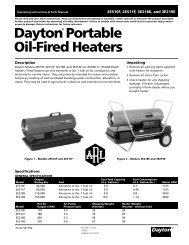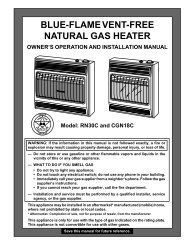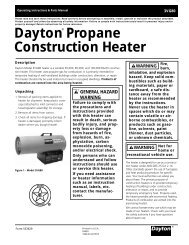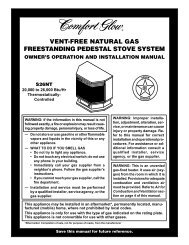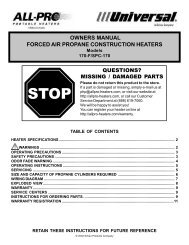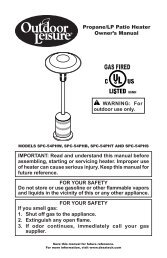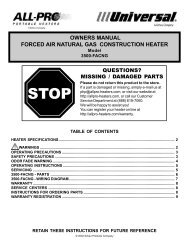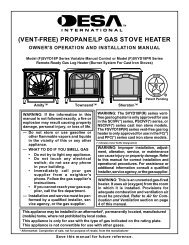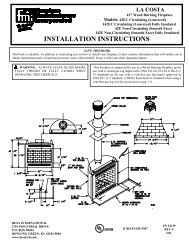AMITY (VENT-FREE) NATURAL GAS STOVE HEATER - Desa
AMITY (VENT-FREE) NATURAL GAS STOVE HEATER - Desa
AMITY (VENT-FREE) NATURAL GAS STOVE HEATER - Desa
You also want an ePaper? Increase the reach of your titles
YUMPU automatically turns print PDFs into web optimized ePapers that Google loves.
104024AIR FORCOMBUSTIONAND<strong>VENT</strong>ILATIONWARNING ICON G 001WARNINGThis heater shall not be installed in a confined space unlessprovisions are provided for adequate combustion and ventilationair. Read the following instructions to insure proper freshair for this and other fuel-burning appliances in your home.Today’s homes are built more energy efficient than ever. New materials, increasedinsulation, and new construction methods help reduce heat loss in homes.Home owners weather strip and caulk around windows and doors to keep the coldair out and the warm air in. During heating months, home owners want theirhomes as airtight as possible.While it is good to make your home energy efficient, your home needs to breathe.Fresh air must enter your home. All fuel-burning appliances need fresh air forproper combustion and ventilation.Exhaust fans, fireplaces, clothes dryers, and fuel burning appliances draw airfrom the house to operate. You must provide adequate fresh air for these appliances.This will insure proper venting of vented fuel-burning appliances.PROVIDING ADEQUATE <strong>VENT</strong>ILATIONThe following is excerpts from National Fuel Gas Code. NFPA 54/ANSI Z223.1,Section 5.3, Air for Combustion and Ventilation.All spaces in homes fall into one of the three following ventilation classifications:1. Unusually Tight Construction; 2. Unconfined Space; 3. Confined Space.The information on pages 5 through 7 will help you classify your space and provideadequate ventilation.Unusually Tight ConstructionThe air that leaks around doors and windows may provide enough fresh air forcombustion and ventilation. However, in buildings of unusually tight construction,you must provide additional fresh air.Unusually tight construction is defined as construction where:a. walls and ceilings exposed to the outside atmosphere have a continuouswater vapor retarder with a rating of one perm (6x10 -11 perpa•sec•m 2 ) or less with openings gasketed or sealed andb. weather stripping has been added on openable windows and doorsandc. caulking or sealants are applied to areas such as joints around windowand door frames, between sole plates and floors, between wall-ceilingjoints, between wall panels, at penetrations for plumbing, electrical, andgas lines, and at other openings.If your home meets all of the three criteria above, you must provide additionalfresh air. See Ventilation Air From Outdoors, page 7.If your home does not meet all of the three criteria above, proceed to page 6.Confined and Unconfined SpaceThe National Fuel Gas Code (ANSIZ223.1, 1992 Section 5.3) defines a confined spaceas a space whose volume is less than 50 cubic feet per 1,000 Btu per hour (4.8 m 3 perkw) of the aggregate input rating of all appliances installed in that space and anunconfined space as a space whose volume is not less than 50 cubic feet per 1,000 Btuper hour (4.8 m 3 per kw) of the aggregate input rating of all appliances installed in thatspace. Rooms communicating directly with the space in which the appliances areinstalled*, through openings not furnished with doors, are considered a part of theunconfined space.* Adjoining rooms are communicating only if there are doorless passageways orventilation grills between them.Continued5




